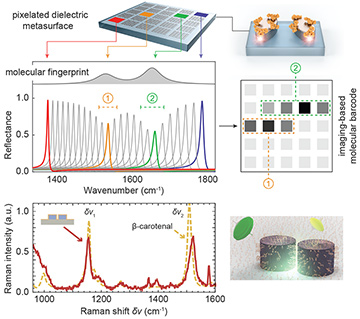 Top: Pixelated dielectric metasurfaces enable a novel platform for surface-enhanced mid-IR spectroscopy by spatially encoding molecular absorption signatures into 2-D barcodes suitable for imaging-based detection. Bottom: Silicon disk dimers provide a new method for surface-enhanced Raman spectroscopy with simultaneous strong enhancements of fluorescence signals. [Enlarge figure]
Top: Pixelated dielectric metasurfaces enable a novel platform for surface-enhanced mid-IR spectroscopy by spatially encoding molecular absorption signatures into 2-D barcodes suitable for imaging-based detection. Bottom: Silicon disk dimers provide a new method for surface-enhanced Raman spectroscopy with simultaneous strong enhancements of fluorescence signals. [Enlarge figure]
Nanophotonics enables control of light-matter interactions using tiny resonant elements that can efficiently focus light into nanoscale hot spots of enhanced electromagnetic near-fields, making these platforms ideal for detecting diverse samples. Surface-enhanced spectroscopy techniques, such as Raman and mid-infrared (mid-IR) absorption, can harness these interactions to extract unique, chemically specific information linked to molecular structure and conformation.
Traditionally, surface-enhanced sensing has relied on plasmonic resonators based on metallic antennas.1 These, however, face significant limitations related to lossy materials and limited CMOS compatibility for mass manufacturing. Dielectric resonators have emerged as an alternative for electric- and magnetic-field control over a wide frequency range.2 Combining arrays of dielectric resonators into metasurfaces can unlock new functionalities for applications such as flat optics and generalized phase control.
Recently, we demonstrated a novel mid-IR spectroscopy technique that leverages a pixelated dielectric metasurface to spatially encode molecular absorption signatures into chemically specific 2-D barcodes.3 This approach creates high-Q resonances by using symmetry-broken resonator geometries supporting bound states in the continuum.4 Assigning different resonance frequencies to different pixels allows one-to-one mapping between spectral and spatial information, and reflectance variations among different pixels correlate with the strength of the molecular absorption signatures.
The setup allows molecular barcode readout using broadband light sources and imaging detectors, enabling spectrometer-free sensing in a miniaturized platform. Multi-component samples containing biomolecules, environmental pollutants and polymers can be analyzed by comparing the barcode of the unknown mixture with a library of reference barcodes, aided by advanced pattern recognition and machine-learning techniques.
Complementing mid-IR fingerprints with Raman active molecular signatures enables characterization of an even wider range of samples. In recent work,5 we have leveraged resonant silicon disk dimers with small inter-particle spacing to show a novel sensor for surface-enhanced Raman spectroscopy with simultaneous strong enhancements of fluorescence signals. Raman signatures of a monolayer of β-carotenal molecules were retrieved with enhancement factors above 1,000, and fluorescence signals could be increased by a factor of 500. Significantly, such dielectric structures are suited for fluorescence measurements on monolayers of emitters with intrinsically high quantum yield.
These novel dielectric metasurface approaches could pave the way toward sensitive, versatile and compact surface-enhanced sensors for numerous practical applications.
Researchers
Andreas Tittl, Filiz Yesilkoy and Hatice Altug, École Polytechnique Fédérale de Lausanne, Lausanne, Switzerland
Stefan A. Maier, Imperial College London, London, U.K., and Ludwig-Maximilians-Universität München, München, Germany
Yuri S. Kivshar, Australian National University, Canberra, Australia
References
1. F. Neubrech et al. Chem. Rev. 117, 5110 (2017).
2. S. Kruk and Y. Kivshar. ACS Photon. 4, 2638 (2017).
3. A. Tittl et al. Science 360, 1105 (2018).
4. K. Koshelev et al. Phys. Rev. Lett. 121 (2018); arXiv: 1809.00330.
5. J. Cambiasso et al. ACS Photon. 5, 1546 (2018).
